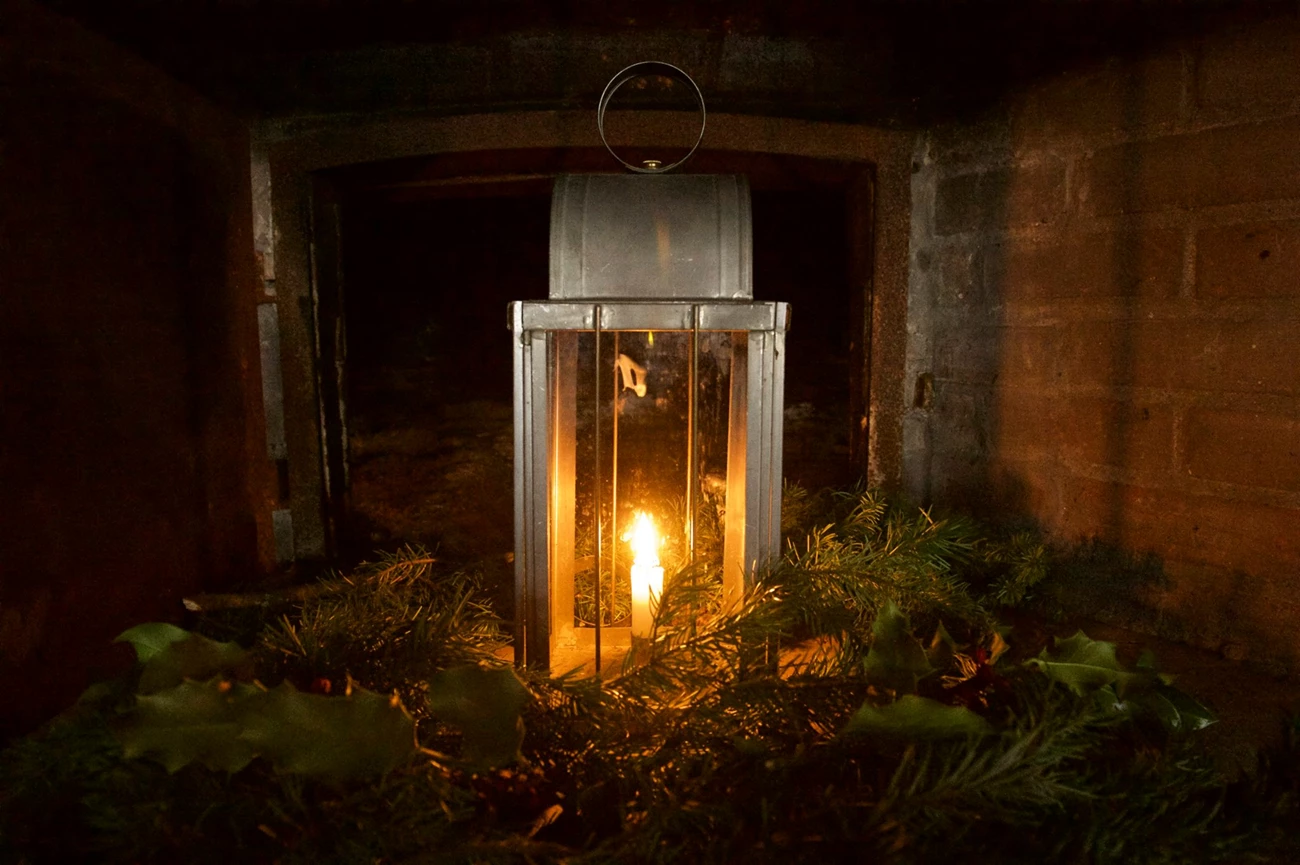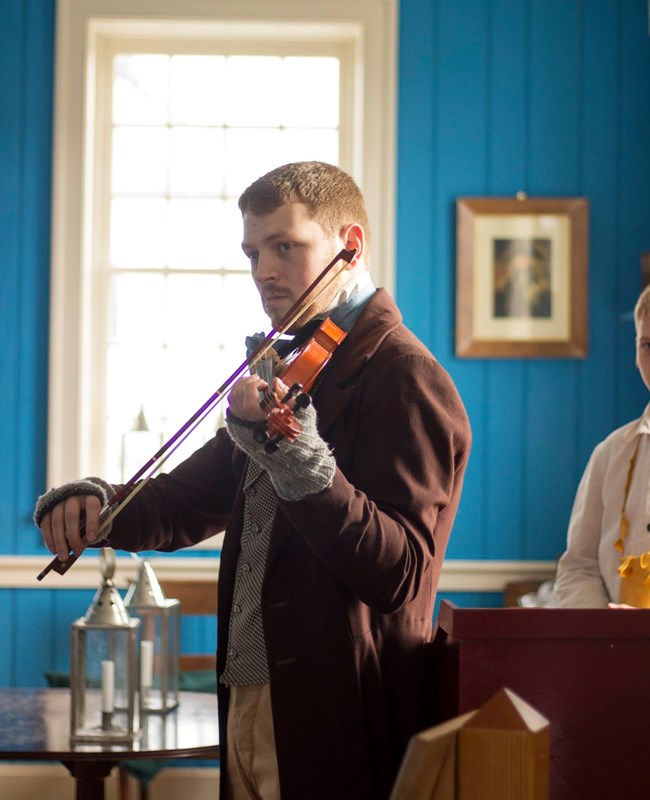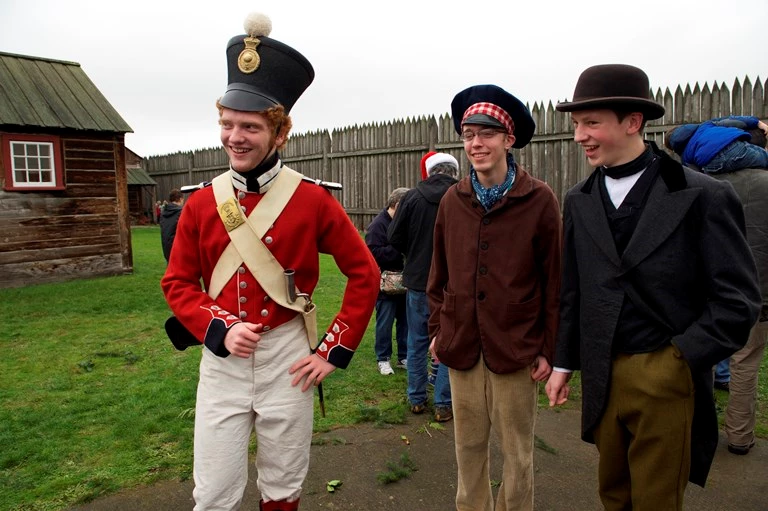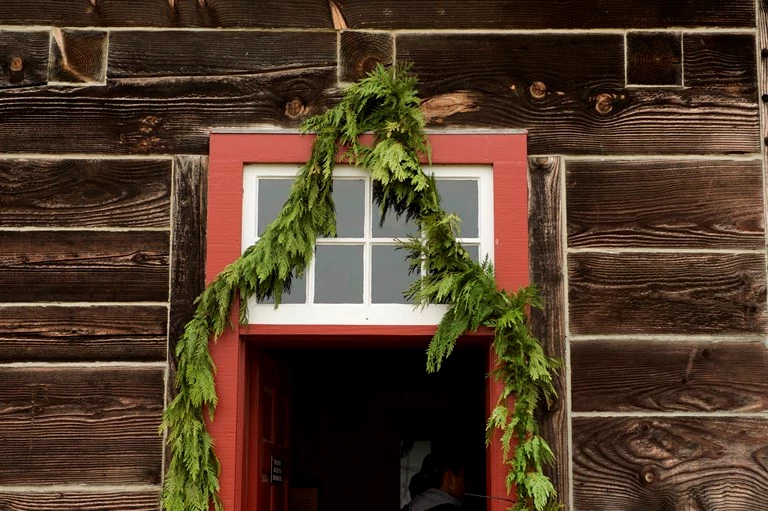Last updated: November 15, 2017
Article
"A General Time of Indulgence and Festivity": Early Winter Holiday Celebrations at Fort Vancouver National Historic Site

NPS Photo by Troy Wayrynen
By Greg Shine
Part I: Christmas
Just as today we celebrate a holiday season, encompassing an array of different holidays and celebrations from late December and January, so did the Hudson's Bay Company employees and families of Fort Vancouver and its neighboring Village, now included within the boundaries of Fort Vancouver National Historic Site.
These 19th century celebrations were both very similar to and markedly different from the ways we celebrate the holiday season today. With the help of fur trade-era journals, letters, books, and newspapers, we can begin to understand how the season was celebrated in the community during its formative years. Today, special events such as Christmas at Fort Vancouver, held each year on the grounds of the national historic site, help connect visitors to these integral traditions of the past.
"The holidays are not forgotten in these far distant regions. From Christmas until after the New Years, all labor is suspended and a general time of indulgence and festivity commences."
- Reverend Samuel Parker, American missionary, visited Fort Vancouver in 1835

NPS Photo by Junelle Lawry
The winter holiday season began in earnest several days before Christmas. In anticipation of the holiday, the HBC would give its employees a "regale": a special treat of food and drink. In 1845, this consisted of "rum and eatables," while a year later it was three quarts of flour, one quart of molasses, three and a half pounds of pork, and one pound grease – "but no Rum," noted Thomas Lowe, an HBC clerk. These regales would be key factors in the revelry to follow.
More spiritual activities began on the day after Christmas. Many of the HBC's working class employees (known as engagés) and their families were of Catholic faith and French Canadian descent, and attended the traditional midnight mass. The midnight mass of 1842 was of particular significance, as Dr. John McLoughlin, Chief Factor at Fort Vancouver, made his first communion and official joined the Catholic faith.
The chapel at Fort Vancouver was "beautifully decorated and brilliantly illuminated...the chant of canticles of Noel, in French and Chinook jargon, alternately by the two choir of men and women, was impressive, as well as the holy performance around the altar; in a word, it was captivating and elevating to the minds of the faithful, commemorating the great day of the birth of our Saviour."
- Father Francois N. Blanchet, 1842
The dawning of Christmas Day brought many of the gentlemen of the fort out and about to bestow the compliments of the season. Clerk Thomas Lowe wrote that he "went the rounds wishing my friends a 'Merry Christmas and many returns of the day.'" An American missionary noted that on Christmas morning the fort's employees and their families would "dress themselves in their best attire, accelerated movements were seen in every direction, and preparation is made for dinners, which are sure to be furnished in their first style, and the greatest profusion; and the day passes in mirth and hilarity."
While record of a Christmas tree at Fort Vancouver may never be uncovered, decorations seem to have been an important part of the holiday season, and the abundance of fir, spruce, and other evergreen trees perhaps contributed to the ornamentation of the fort. British Army Lieutenant Henry J. Warre noted that the visiting Royal Navy ship HMS Modeste was "very prettily decorated and festooned with Holly and Evergreens" in 1845, while at another Northwest post Father Blanchet rejoiced in the "garlands and wreaths of green boughs" he found adorning a church.
Outdoor leisure activities were popular with the fort's upper class, especially shooting, hunting, and riding – when weather and health permitted. On one occasion, Thomas Lowe had "rather a dull time of it" when rain foiled his plans to be outside on Christmas morning. On another, he explained that a measles outbreak caused "so much sickness in the fort, [that] we had no amusement during the day." The fort's working class also indulged in the outdoors. "Some engaged in gambling," American pioneer Joel Palmer noted, "some singing, some running horses, many promenading on the river shore, and others on the large green prairie above the fort."
Worship also played an important role in the day's festivities, with various services held in the morning and afternoon for the fort's diverse population. Catholic services, in French, took place at the Catholic Church – first inside and then later outside the stockade walls – while other Christian services, in English, were often held in the dining room of the Chief Factor's House and led by James Douglas, another HBC officer or a visiting missionary or minister. By 1844, William Kaulehelehe had begun conducting Christian services in native Hawaiian language for the many Hawaiian employees at the fort.
One of the day's highlights was the Christmas dinner. Perhaps the grandest of these dinners was that of the HBC's officers. On Christmas Day at three o'clock, an extraordinary feast would take place within the fort, featuring traditional English fare such as roast beef and plum pudding. Often, there would be several lavish dinners held throughout the day. In 1845, sailors from the HMS Modeste hosted "a Christmas feast that the table groaned under," according to Thomas Lowe.
In 1849, HBC officers joined the recently-arrived U.S. Army officers at their dining hall, near what is today the Great Meadow at Fort Vancouver National Historic Site. In the eyes of HBC attendees, something important was missing at that American dinner: alcohol. "They gave us temperance – or rather total abstinence dinner, which none of us relished much. Made up for it however on our return Home," noted Thomas Lowe sardonically.
Indeed, alcohol played a major role in fur trade-era celebrations. For the officers, Lowe recounted that "the wine was freely circulated" at Christmas dinner and intoxication often resulted. "The ladies all behaved well," wrote fort visitor Letitia Hargrave, "only my friend Betsy 'got dronk' as she told me and was carried home." For the working class, rum was the drink of choice; it provided a welcome rest from the rigors of work, and ensured that the "ranting and frolicking" observed by Joel Palmer at the fort's 1845 Christmas celebration was sure to follow.
The celebratory spirit fostered by the many Christmas dinners continued to grow as balls, dances, and parties lasted well into the evening. Inside the walls of the fort, activities such as card parties involving whist and other games seem to have dominated, while outside the stockade a different level of merriment ensued. Visitors to the area both noted and enhanced the party-like atmosphere. "Most gloriously drunk," was how Joel Palmer described the attendees of a party hosted by sailors aboard the Modeste. "[J]udging from the noise kept up until ten at night, they were a jolly set of fellows," he exclaimed. Inside the fort, the activities were different. "On shore we had nothing better to do than amuse ourselves at cards," bemoaned Thomas Lowe.

NPS Photo by Troy Wayrynen
Part II: New Year's Day
"Singing, dancing, and all kinds of fun carried on to a late - or rather early - hour in Bachellor's Hall, ushering in the New Year."
- Thomas Lowe, clerk at Fort Vancouver, December 31, 1845
With a few exceptions, the days between Christmas and New Year's Day were holidays to the employees and families of the Hudson's Bay Company's Fort Vancouver, and the respite from work, coupled with additional gifts from the Company, made for a lively and often raucous holiday week.
For the site's working class employees (known as engagés) – many of them of French Canadian, Hawaiian, and Métis heritage – regales or special treats of additional food and drink continued to be popular throughout the season, especially before New Year's Day. In 1844, on account of it "being the last day of the year," Thomas Lowe recorded in his journal that the fort's employees received a regale of beef, flour, and a half pint of rum. Two years later, he noted that they received, "the same as on Christmas, but this time they had a pint of rum to make themselves merry with." These additional provisions, no doubt, enabled the working class revelry to continue, for beef and flour were highly coveted and alcohol was highly regulated and difficult to obtain.
The week between Christmas and New Year's Day celebrations also ushered in a continuous flow of social activities for the fort's gentlemen and their families. Dances, balls, and card parties reigned in popularity. Even the often staid Dr. John McLoughlin, an HBC chief factor for many years, got into the spirit, hosting card parties in his personal quarters during the holiday season of 1844.
As the town of Oregon City grew with increased American emigration, additional leisure activities emerged for HBC employees and their families during the week between Christmas and New Year's Day. In 1849, many of the fort's gentlemen brought their families to Oregon City, where they joined local citizens at a ball hosted by Joseph Lane, then governor of Oregon Territory. "A party of the regimental band performed during the evening," Thomas Lowe wrote, "and the party did not break up until between two and three o'clock in the morning." The following day, Lowe and friends enjoyed breakfast with the officers of the U.S. Army's Regiment of Mounted Riflemen, where they "heard their beautiful brass band perform." For those who think shopping during the holiday season is a relatively new tradition, consider that Lowe noted that he and his party then "passed the day shopping and strolling" through Oregon City.
All of these social activities continued as the calendar advanced toward New Year's Day. While today Christmas seems to have eclipsed it as the season's most popular and celebrated holiday, during the fur trade era New Year's Day held this distinction.
The dawning of New Year's Day brought many of the fort's gentlemen out and about, visiting and conferring upon each other the compliments of the season. Thus, on January 1, 1846, Thomas Lowe noted in his journal that he "visited all of the ladies in the Fort to wish them a Happy New Year and many returns." Although not considered a religious holiday, religious services were held – always when the holiday fell on a Sunday, and occasionally when it did not. Outdoor activities were also popular – weather permitting. On New Year's Day 1848, for example, Lowe recorded that "the only way we could enjoy ourselves was taking our guns and pistols and firing at a target."
A large, formal dinner normally took place at 3 pm, often including visitors and guests. In 1850, the gentlemen at the fort hosted several of the U.S. Army's artillery officers from the new military post on the ridge just above the fort. "The dinner was kept up until rather an unusual hour at this place," remembered Lowe, "and one or two of the officers indulged pretty freely."
After dinner, the celebration continued; some years it seems to have been large and boisterous, in others is seems to have been more intimate and sedate. For example, in 1846, Lowe related that they "had a splendid Ball up in the Hall, which went off remarkably well and was kept up until 3 o'clock in the morning, after which we sat down to supper." In 1850, Lowe noted that the fort's Dr. Forbes Barclay hosted a card party in his room, featuring the game of whist.
The coming of January 2nd did not necessarily mean the end to the holiday season; it often extended for several days into the new year. For example, in 1846 sailors from the Royal Navy's HMS Modeste thrilled the fort's employees and families when they put on a series of theatrical performances aboard the vessel, complete with singing and a hornpipe between acts. "We went ashore at about 12 at night highly delighted with the evening's entertainment," wrote Lowe.
Soon, however, the celebrations ended and the routine of the fur trade shifted back to its often harsh and humorless nature. "This morning work was resumed," noted Lowe on January 4, 1848, "and I consequently returned to the office."
Today, special events such as "Christmas at Fort Vancouver," held annually on the grounds of Fort Vancouver National Historic Site, help connect visitors to these integral traditions and celebrations of the past.

NPS Photo by Troy Wayrynen
